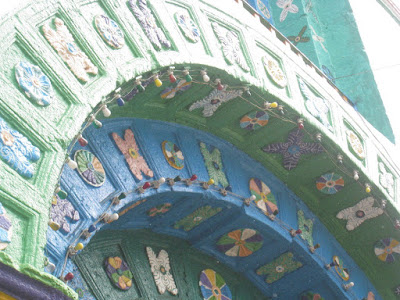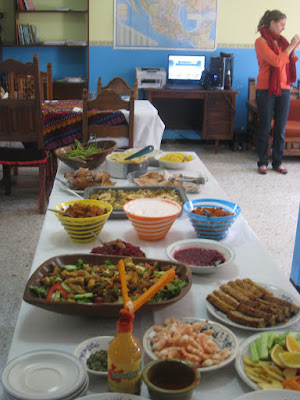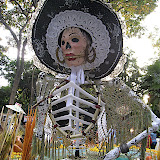Today was our much-needed day off. So I went to Palenque. Palenque: Just saying the word makes me feel like Indiana Jones…
Ever since one of our program directors, Randy, spoke in awestruck tones about Chiapas’ most famous ancient Mayan ruins, I knew I had to find them. I doubted our Chiapas immersion trip would have time for an extracurricular, but then our Sunday plans fell through and suddenly we had 24 hours of free time. Nobody else seemed particularly excited about a 10-hour round trip excursion crammed into one day, so I shrugged and bought a solo ticket for a one-day trip to Palenque and back.
There wasn’t enough in my budget for one of the high-end tours advertised everywhere in San Cristobal, so, with some help from Kim, I found a cheap basic tour at a backpackers’ hostel a few blocks away from our hotel. Reserving my ticket was kind of a mess because the clerk spoke Spanish way too fast for me, but I finally figured out that I was supposed to be at the hostel front door at 6am Sunday morning. I had no paper ticket, no proof that I had just shelled out a bunch of money, just instructions about a place and a time.
I showed up in the chilly early-morning hours bundled up in my scarf and hat. About 6:30 someone yelled from across the plaza: “Mateo?” I turned around – sure enough, there was a van with a dude standing outside of it holding a clipboard. “Si,” I called back, and ran after him.
The little van ascended up into the mountains. The hour was earlier than either of my other excursions from San Cristobal, and the morning clouds had not yet lifted. The mountain forests were unbelievably misty (good prep for an Indiana Jones day, I think), and sometimes the clouds were actually below the mountain road, as if we were in a low-flying airplane. Even in the van, the temperature was cold.
After about two hours we stopped for breakfast. I didn’t really want breakfast, I just wanted to get to Palenque, the earlier the better, but the van was stopped, like it or not, so I piled off with the rest of the passengers. Then I spotted coffee. Ok, I guess I’ll have breakfast. Afterwards I discovered the breakfast cost 70 pesos ($7). So much for saving time and money on the cheap tour…
About an hour after breakfast we stopped at a waterfall. I didn’t really care about the waterfall, either – I just wanted to get to Palenque! – but it ended up being pretty sweet anyway. I stepped off the bus, and immediately realized we weren’t in the highlands anymore. I peeled off my scarf, hat, jacket, fleece…we had gone from about 30 degrees that morning to about 80 degrees by lunchtime. This was going to be a good day.
I climbed up to the lookout point, took some pictures of the waterfall, wandered through the jungle a bit, crossed some rickety wooden bridges, waded out toward the waterfall and stumbled around on some rather dangerous-looking wet rocks…we only had about 30 minutes, but I had been on a bus all morning and the tropical temperature was waking me up…
We piled back into the van, but before leaving the driver made a little speech in which I think he was asking us whether we wanted to visit another waterfall or not. Some kind of complication was involved. Finally he handed out a sheet of paper that we were all supposed to sign. The sheet of paper basically said (in both English and Spanish, helpfully) that there were social and political problems in the area, and due to these problems we would not be visiting some other waterfall we would normally visit. Ok, whatever – I just want to get to Palenque, remember? I signed it and passed the sheet on. Twenty minutes later we visited the waterfall anyway.
Finally, after breakfast, two waterfalls, and five hours in a van, we finally made it to Palenque.
And it was so worth it.
I looked at my watch – only an hour and a half until closing! I listened impatiently to the complimentary tour guide, then ditched him as soon as he turned his back (my Lonely Planet had a built-in Palenque guide anyway – Lonely Planet, what aren’t you good for?), running off to climb the nearest pyramid, which turned out to be a giant ancient palace with a courtyard and crumbling ancient hallways! I had a request a few weeks back (thanks, Hannah) for more photos with people in them, so I set up my camera on self-timer, carefully positioning on some rocks here, there – everywhere! – and then running in front of it before it click! took the picture. It was a crazy amount of fun. Ruins, I think, are like playgrounds for adults. Or, at least, playgrounds for adults like me who like to pretend they are Indiana Jones…
You can see for yourself (photo gallery above) how cool Palenque was. Like Chichen Itza, Palenque is buried deep in the jungle; like Xochicalco, Palenque lies on higher ground, offering gorgeous views of the surrounding valley. (Palenque actually lies on the edge of the Chiapas mountain range, and from its highest pyramid you can look out over the flat plains that begin the landscape of the Gulf Coast – incredible!) But in addition to combining the best of other sites, Palenque also has fascinating architectural innovations, like roof combs and lookout towers. Indy would love it...
I ran around Palenque for an hour and a half – the Indiana Jones theme song playing in my head the entire time – then stepped through the exit at precisely 4:30, closing time. I bought a Coke for the ride home, then stepped into the van and collapsed into my seat. I wouldn’t get back to San Cristobal until 10pm, 15 ½ hours after I left that morning.
As the van pulled away from Palenque, I cracked open my Lonely Planet guide to make sure I had seen everything I was supposed to. Satisfied, I turned the page – and found some more ruins to visit! Apparently there are these ruins at Yaxchilan, near Guatemala, that you can only get to by taking a boat down a river... (Cue theme music and end credits…now.)
The shining
2 days ago

















